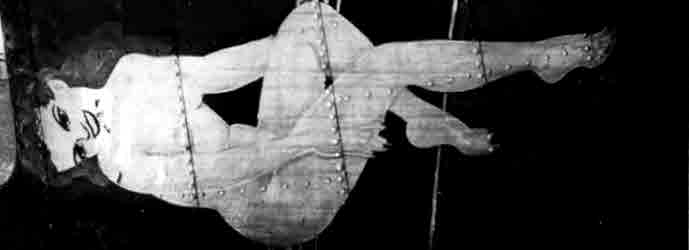BITS AND PIECES - ENGINES AND WING
Good Evening All, and a reflective Memorial Day Eve for the other Americans in the audience.
The collaboration between H.G. and me is going very well. He asks
a lot of technical questions and has the same passion for getting it right that I do:
plus time and a fabulous skill-set. I have no reservations, at all, about the decision to enlist his help in getting this personally important project of mine done.
We last left off discussing black vs. aluminum cylindered engines on 303rd A/C.
The below picture of
Luscious Lady undergoing engine maintenance

convinces me that she had at least one black engine at some point in her career. We will stick with at least one, in the #4 position, as shown in the photo.
H.G. and I have had a number of discussions about engine details. These have dealt with various oil pipes going from cylinders and the oil sump at the bottom of the gearbox in the front. You can see these pipes pictured in the brass fret below,

and in the Eduard instruction excerpts below.


A better depiction of his work on this piping is depicted below.

I am impressed at how this "upgrade to the upgrade" is going!
My old employment as a lawyer for Curtiss-Wright, who dealt with radial engine parts contracts at the very end of this product line's life for the Company, makes me especially sensitive to accuracy in modeling theses remarkably complex machines. If you want a good video on what it took to make the real thing check out
this wonderful 1942 C-W video available on YouTube! Moving right along to the wing, here are a couple of detail shots of H.G.'s initial rescribing work on the green stbd wing:


Finally, here is the initial cut at re-scribing the entire stbd wing.

A conscious decision was made
not to re-scribe all the rivet detail on the wing. My input on it is that sometimes there can be too much of a good thing if scale effect is ignored, as illustrated by this excerpt from
Gullliver's Travels: A VOYAGE TO BROBDINGNAG. Caution:
NSFW. But, I digress. Note above in the wing scribing job how the raised sections where the deicer boots would go have been eliminated. This is because they were removed in combat, and in the case of Group A/C at this time, the bare aluminum was painted over. See the below picture of a contemporary B-17 of the 384th BG, a member of the 41st Combat Bomb Wing (CBW) that the 303rd regularly flew with.

Tomorrow let's remember the fallen in all wars, friend and foe alike.
 ) was sent to HG yesterday.
) was sent to HG yesterday.







































































